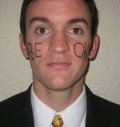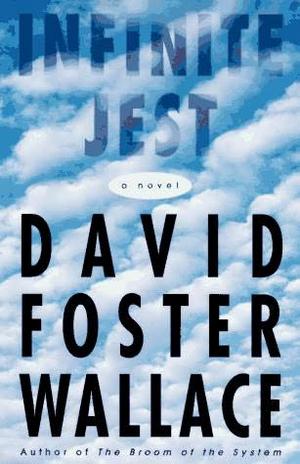
[“Butterfly Suicide II” by DoNotAttempt]
 BY DAVE ALLEN News of “Infinite Summer,” the just-launched group-read of David Foster Wallace’s massive and masterful tome Infinite Jest in just over three months — or roughly 75 pages a week — spread at a near-viral pace, at least in the literary world. The initiative, sort of an invisible national book club, launched on June 21st with both an official site and Facebook group recruiting “endurance bibliophiles.” If that sounds like you, get a move on because according to the web site: Infinite Summer is 9% complete. I’m not participating, in part because I read the book over the course of several months last year, beginning in the late summer and then wrapping it up in November. Between the time I started and the time I finished, Wallace committed suicide, depriving the world of a profound and deeply moral voice.
BY DAVE ALLEN News of “Infinite Summer,” the just-launched group-read of David Foster Wallace’s massive and masterful tome Infinite Jest in just over three months — or roughly 75 pages a week — spread at a near-viral pace, at least in the literary world. The initiative, sort of an invisible national book club, launched on June 21st with both an official site and Facebook group recruiting “endurance bibliophiles.” If that sounds like you, get a move on because according to the web site: Infinite Summer is 9% complete. I’m not participating, in part because I read the book over the course of several months last year, beginning in the late summer and then wrapping it up in November. Between the time I started and the time I finished, Wallace committed suicide, depriving the world of a profound and deeply moral voice.
But be forewarned, much like James Joyce’s Ulysses, which gets a similar let’s-do-it! groupthink push every June 16th, aka Bloomsday, Jest frustrates expectations and so frequently interrupts the linear, cover-to-cover trajectory that the pleasure of progress, of feeling that you’re moving towards an end, is held at bay in the book’s vast thousand-page expanse. Still, Jest contains a number of elements that make it an almost-ideal summer read. The opening passage so effectively renders the radiation of heat off the sidewalk that it made me sweat. There’s outdoor recreation of all kinds, including the furiously competitive games at the Enfield Tennis  Academy, where students play a nuclear-warfare-simulation game with incredibly baroque rules that bring to mind a warped version of Calvinball, the sport invented by Bill Watterson in the comic strip “Calvin and Hobbes.” Mimicking the outlook of the teenagers at the Tennis Academy, a streak of juvenile humor runs through the proceedings. Geopolitical reconfigurations have turned the United States, Canada and Mexico into the Organization of North American Nations, or O.N.A.N. Yes, a masturbation reference, and other running jokes — which seems like too lowbrow a term to use; they’re more like humor-motifs — include the corporate sponsorship of calendar years (much of the action takes place in the “Year of the Depends Adult Undergarment”), the glorious butchering of English by French-Canadians, and the complete ineptitude of President Johnny Gentle, a staggeringly obsessive-compulsive former lounge singer.
Academy, where students play a nuclear-warfare-simulation game with incredibly baroque rules that bring to mind a warped version of Calvinball, the sport invented by Bill Watterson in the comic strip “Calvin and Hobbes.” Mimicking the outlook of the teenagers at the Tennis Academy, a streak of juvenile humor runs through the proceedings. Geopolitical reconfigurations have turned the United States, Canada and Mexico into the Organization of North American Nations, or O.N.A.N. Yes, a masturbation reference, and other running jokes — which seems like too lowbrow a term to use; they’re more like humor-motifs — include the corporate sponsorship of calendar years (much of the action takes place in the “Year of the Depends Adult Undergarment”), the glorious butchering of English by French-Canadians, and the complete ineptitude of President Johnny Gentle, a staggeringly obsessive-compulsive former lounge singer.
The only rule in the aforementioned Calvinball is “Anything we make up” goes and a similarly improvisational vibe persists in Jest. Wallace’s polymath pedantry infuses everything: an extended passage on improvised tattoos gives way to clinical discussions of anti-depressants, which gives way to an elaborate depiction of freebasing cocaine, and the mechanics of mapping the streets and public transportation of greater Boston. Jest constantly shifts perspectives from halfway-house inmates, to overdosing transvestites, to government bureaucrats, and cross-dressing undercover spies, spanning an epic, albeit fractured narrative arc girded by voluminous footnotes which take up more than 100 pages at the back of the book. In a letter quoted in a fascinating if depressing New Yorker article published back in March detailing his final days, Wallace explains that the footnotes “mimic the information-flood and data-triage I expect’d be an even bigger part of US life 15 years hence.” The letter is from 1994, and the observation could not be more dead-on. Even though the novel’s channel-changer-meets-academic-paper aesthetic lurks behind the veil of fiction, the detail of “Jest” is so rich and engrossing as to suggest a mirror reality, one as meticulously rendered and flawed as our own.
The wild variations in subject matter, style and voice, of course, bring me to the difficulties of Jest, which go beyond its size. Even if read in the midst of summer, the heart of the book is the dark winter of the soul. A terrorist group from Quebec is ruthlessly pursuing a closely-guarded secret, and the scenes of the tortures and murders they execute to find it wallow in the very worst of humanity. The Incandenza family, central to the novel and entangled deeper than it knows in Quebecois separatism, engages in emotional manipulations that go way beyond dysfunctional, from the frustrations of the brilliant, monomaniacal father and supposed incest by the mother to derangement and deformation of all sorts in their three sons. Countless characters struggle with addiction, including a talented young man — who, judging by the biographical details that have emerged in the wake of his death, could well be a stand-in for Wallace — wrenched with panic over the hold that drugs are beginning to have over him. The novel closes with the rambling, pain-stricken thoughts of a former addict, pulled back and forth by dark and light forces while he lies comatose, refusing painkillers. If the fragmented point-of-view makes Jest a difficult read, its subject matter sometimes makes it a deeply unsettling one.
 Shaking us into greater awareness seems to be the novel’s higher purpose, and Wallace reserves his sharpest indictments for the meaningless entertainments of the media-industrial complex and the psychoactive control they assert over our lives. A recurring subplot concerns a forbidden film, traded on the black market, so enthralling that all who watch it lose their desire to do anything else. Likewise, Wallace rails against mere entertainment masquerading as newsgathering. In the book, it’s a “soft profile” of a pro athlete that brings about much of the intrigue, and that manifestation of bland, uncritical journalism — which, much like cable news, does not really tell us anything, but somehow gives us the distinct impression that it has — echoes disturbingly far beyond Wallace’s fictional realm.
Shaking us into greater awareness seems to be the novel’s higher purpose, and Wallace reserves his sharpest indictments for the meaningless entertainments of the media-industrial complex and the psychoactive control they assert over our lives. A recurring subplot concerns a forbidden film, traded on the black market, so enthralling that all who watch it lose their desire to do anything else. Likewise, Wallace rails against mere entertainment masquerading as newsgathering. In the book, it’s a “soft profile” of a pro athlete that brings about much of the intrigue, and that manifestation of bland, uncritical journalism — which, much like cable news, does not really tell us anything, but somehow gives us the distinct impression that it has — echoes disturbingly far beyond Wallace’s fictional realm.
“Infinite Summer” comes at a time when Wallace’s grand bargain has been undercut somewhat by the publication of his 2005 speech to graduates of Kenyon College. Titled This is Water: Some Thoughts, Delivered on a Significant Occasion, about Living a Compassionate Life, the book subdivides the speech and metes it out one sentence per page, framing each line as a kind of Zen utterance. The crux of the speech, a joke about the lives and observations of fish that opens up into a discussion of mindfulness and the increasing difficulty of paying attention to what truly matters in the data-crowded echo chamber of modern living, is also one of the primary underlying themes of Jest.
This wise old whiskery fish swims up to three young fish and goes, ‘Morning, boys, how’s the water?’ and swims away; and the three young fish watch him swim away and look at each other and go, ‘What the fuck is water?’ and swim away.
Learning in that same New Yorker article that much of the Jest‘s writing took place in Syracuse, New York — a city I lived in for two years before coming to Philadelphia — was, for me at least, the biggest bummer in an article rife with disturbing revelations. If DFW could be so prolific in such a bleak, nothing-to-do setting, why did I spin my creative wheels during so much of my time there? As with Wallace’s suicide, there is no satisfying answer to the question of why — other than, I am no David Foster Wallace. Still, we’ll always have “Infinite Summer,” and if you haven’t gotten on the bandwagon yet, you’re only 75 pages behind. You’ll catch up quickly, and I know you’ll find something in the novel that so closely approximates your own thought processes, or the overstimulated times in which we live, that you’ll be shaken into a new awareness. David Foster Wallace is dead, long live David Foster Wallace. Or, to paraphrase Samuel Beckett, a writer whose unrelentingly bleak outlook finds common cause with Wallace’s end-of-life nihilism: He can’t go on. We’ll go on.
PREVIOUSLY: INFINITE JEST — David Foster Wallace Kills Self
